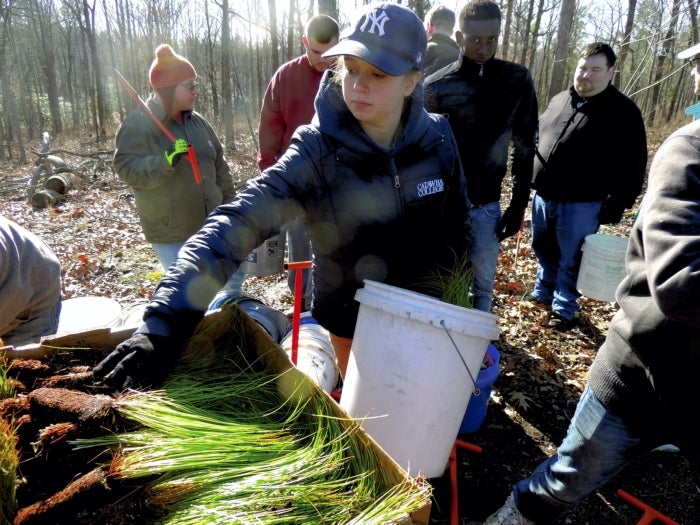Catawba students help preserve Piedmont longleaf pine
Published 12:00 am Thursday, March 26, 2015

- Catawba College student Jennifer Beach puts long leaf pine seedlings in her bucket to plant at Black Ankle Bog. Submitted.
Seventeen Catawba College students spent the first cold and clear day of their spring break volunteering with The Nature Conservancy to preserve the Piedmont longleaf pine.
The students traveled one hour southeast to Montgomery County—the heart of the Uwharrie National Forest — to visit Black Ankle Bog, a 284-acre preserve managed by The Nature Conservancy. Black Ankle is one of the few remaining examples of Piedmont bogs and features unique plant and animal communities maintained by frequent wildfire.
According to local histories, the unusual name for the Black Ankle Bog may have come from the naval store industry where longleaf pine tar and pitch were harvested for sealing and treating wooden ships – harvesting the pine tar and pitch was a dirty job that could result in black ankles. An alternative hypothesis for the name is attributed to barefoot miners returning from nearby Black Ankle Gold Mine.
The student volunteers were led by Dr. Forrest Anderson and Dr. Jay Bolin, and were enrolled in either Bolin’s natural resource management and ecology course or Anderson’s advanced academic writing course with an emphasis on environmental writing.
Jessie Birkhead, The Nature Conservancy’s coordinator for the Piedmont, arranged the longleaf pine planting event and provided training for proper planting technique for the hundreds of seedlings.
“The Catawba students worked so fast and effectively, they are welcome back anytime,” Birkhead said.
Black Ankle Bog is ringed by interesting longleaf pine communities that are on clay-loam soils very different from the typical soils of longleaf such as the white sugar sands of the Sandhills and Coastal Plain.
“It’s so strange to see longleaf growing on clay and rocky soils,” said Chris Bolick, a senior environmental science student from Asheville.
After the morning longleaf pine planting, the students visited the ecologically important bog. The upland course frogs were in full trill. Numerous rare plants were observed including a variety of pitcher plants that depend on frequent fires to keep their habitat open and relatively unshaded.
“I was surprised by the benefits long leaf pines bring to the habitat, like how they use less water and are meant to live by fire,” said Maria Adkins, a junior English major from Salisbury.
At the end of the day, students expressed the desire to return in a few years to see how their planting transformed the landscape and reflected on their volunteerism.
“It was nice to be out here with a group coming together with the same purpose. I think it’s so great that Dr. Bolin was able to do this for us,” Adkins said. “I’m very glad I was a part of it.”


